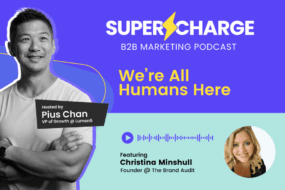
We talked to 20+ B2B marketers and gathered their thoughts on the Buyer’s Journey to uncover trends and thoughts around the new problem that all B2B companies face. With the recession continuing to determine an undetermined fate for companies, standing out in a saturated market is your sure fire way to success. But what can brands do? How do brands pivot? Our series Marketing Experts on: the Buyer’s Journey hopes to answer all questions and provide more insights.
Buyers now are skeptical towards sales. Not that sales has earned a bad rep, but with information readily available left and right, buyers are spending more time away from sales and more time doing their own research. How can brands “go to market” and catch the eyes of buyers in this social media age?
Brands should think about positioning themselves differently. How so? Well, although buyers are external facing to the company, there needs to be a shift that happens internally.
As the modern yet complicated buyer’s journey has become a marketing-led buyer’s journey, marketing and sales responsibilities and roles have also shifted.
Alice Ko, Head of Marketing sums up the new relationship perfectly:
And after adjusting internally, external marketing efforts such as content creation and positioning need to shift as well. Thus leading to questions, such as “Where should marketing focus their efforts? How should marketing position themselves in this new buyer’s journey?” How can brands pivot quickly and successfully? Here’s what we’ve found..
MARKETERS NEED TO BE WHERE THE BUYERS ARE.
Brands need to be where their buyers are and that’s not waiting by the phones, but in online communities, social media platforms, review sites – anywhere your name could be searched! Buyers are looking for that inside scoop on a brand’s product or solution, but the catch: NOT just content from the brand but from others who have first-hand experiences.
Be where your buyers are! Justine Woo lists great places to be, such as G2 Capterra, along with what has worked for her in the past:
And one thing Justine mentions is something that other B2B marketing experts also mentioned, “How do you differentiate yourself from the rest?” You need to stand to from the marketplace to get the attention from buyers.
MARKETERS NEED TO CREATE. DISTRIBUTE. AND TELL IT AGAIN.
The internet doesn’t sleep and nor do those auto-refresh timelines. (SMH!) The shelf life of content is so short that content becomes irrelevant quickly.
Because of this top brands such as Hubspot or Later, are providing additional and in-depth content to guide users to make more informed decisions or educate further by filling in any missing pieces. 68% of buyers feel a much more positive feeling after reading useful content. And thus, will likely lead to a purchase where B2B buyers are confident and experience a higher degree of purchase ease. That’s another champion for another case study or review!
In our last blog post, Sean Sandhurst had summed up the buyer’s journey best – saying that as long as marketers had the right message at the right time with the right channel, a message could reach and resonate. But being consistent in messaging and distribution is so essential.
But how can marketers disseminate the same knowledge from a different perspective? Sean Sandhurst breaks down his approach in 3 simple questions, while Desmond Liao weighs in with thoughts on utilizing Founder-led Marketing.
Desmond Liao, VP of Marketing
YOU ARE THE EXPERT. BECOME THEIR EXPERT.
Desmond touches upon something VERY key: positioning your brand and different people in your brand as thought leaders in the space – whether that’s any C-level execs or any Marketing personnel! Becoming the go-to expert is great way to leave not just a first impression, but a LASTING impression!
As an expert in the space, buyers will turn to you for guidance and can inform and help your audience make purchase decisions based on the actual truth. Or, lead them to their own new conclusions and understanding. Either way, it’s a win-win – you gain your audience’s trust and respect.
At the end of the day, the buyer will choose what’s best for them.
And it’s not necessarily the cost or the product itself that’s the deciding factor, but the brand they most trust in. 80% of buyers are looking not for the brand with the best offering, but one that aligns with their own values. A brand that they can trust to help guide them.
Is there one right way to achieve this? No there isn’t. Again, different content formats and content resonate with different buyers, but Matt Lim suggests one way that might actually be the change in B2B Marketing entirely.
His solution? Video. His reasoning? It’s more consumable in mixes of short-form and long-form videos.
Videos can create instant reactions, making your video much more relatable. Brands can trigger emotions through visuals, audio, and words, communicating and connecting with your audience on a variety of levels while greatly deepening trust in the process.
Simply put, emotional storytelling resonates with buyers’ problems while providing viable solutions. Video gives marketers the chance to position their brand as the expert. And as Matt suggests, video is not a one size video fits all, but a way to encourage conversations and educate buyers in more consumable way.
Subscribe to learn everything about video.
Let’s get you started on your video journey! We’re here to help and would love to provide you with more video tips and tricks, while keeping you up to date with video marketing trends.
DON’T WORRY,
providing us with your email does not mean we will be reaching out.





